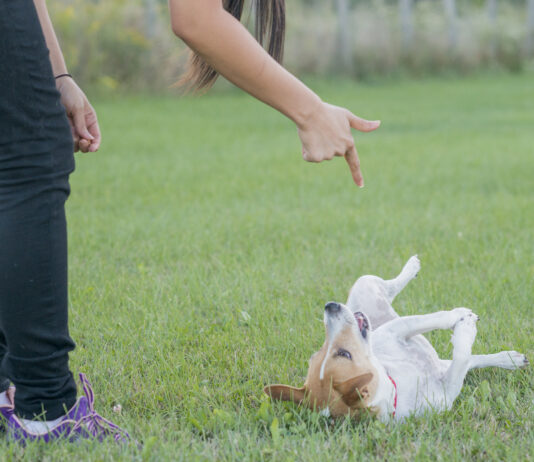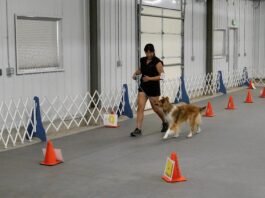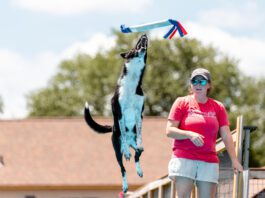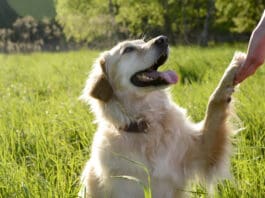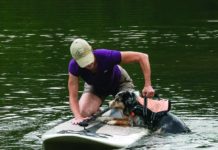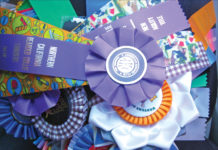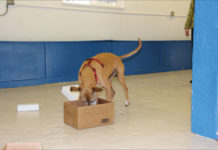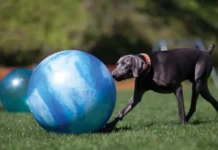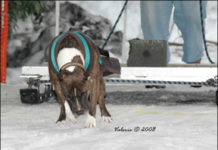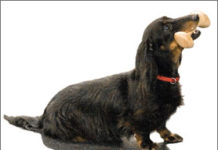Stand-Up Paddleboarding With Your Dog
A stand-up paddleboard (SUP) is similar to a surfboard, though one paddles a SUP while standing. As a former avid whitewater kayaker, when I first saw photos of people on SUPs, I thought, Why in the world would anyone want to do that?" Where was the excitement? The adrenaline?"
Take Your Water-Loving Dog Dock Diving!
Summer! It's the perfect time for dock diving. In this canine sport (also known as dock jumping), the participating dog jumps off an elevated diving platform into a portable pool and the dog with the longest jump is deemed the winner. I think dock diving is possibly the best canine sport for spectator enjoyment. And, if you decide to compete, you can easily redline the FUN meter! Besides the joy of hanging out with my dog by a cool body of water, the one thing I love about the sport is that with just a few dog and handler skills, any person and any breed of dog and size of dog can participate.
Dog Certifications and Titles
My friend has super fast dogs, and they compete in agility. I always imagined that the magnets on the back of her vehicle indicated just how fast they could run: MACH speeds! And C-ATCH: Catch me if you can! Obviously my Border Collie, Duncan, and I didn't get far enough in our brief agility career to earn any titles (he preferred to make up his own courses). But when my curiosity got the better of me and I looked into what, exactly, those letters on my friend's car actually meant, I quickly learned that there are countless titles and certifications that can be bestowed upon our canine companions.
The Clever Hans Phenomenon
Clever Hans was a German horse in the early 1900s who was supposedly able to solve math problems and perform other amazing tasks. His owner, math teacher, amateur horse trainer, and mystic Wilhelm von Osten, said Hans could add, subtract, multiply, divide, work with fractions, tell time, keep track of the calendar, differentiate musical tones, and read, spell, and understand German. When given a math problem either orally or in writing, Hans would answer by tapping his hoof.
Dog Games To Play if You Are Physically Impaired
How to exercise yourself at the same time you exercise your dog was the subject of Fitness Together" in the April 2013 issue of WDJ. But there are many reasons the human half of the equation may not be up for much physical exercise
Sniff This; You’ll Feel Better
Shelter volunteer Katherine Kekel stood at the end of a long hallway and struggled to keep a grip on Tia, a pit bull-mix, as the dog strained at her harness. Unable to contain the dog any longer, Katherine let go. The well-muscled dog sprinted down the hallway, put on the brakes, and made a sharp right turn into a small room. The hunt was on! Tia was playing K9 Nose Work® at the Cherokee County Animal Shelter (CCAS) in Canton, Georgia. Her prey? A cotton swab scented with birch essential oil.
A Strong Recall is Critical During Your Dog’s Water Play
No matter how strong your dog’s recall may be (and we recommend it be quite strong if you’re considering letting your dog off-leash at the beach, lake, or river), it’s important to remember that the excitement of being in the water, coupled with the potential desire to swim out for a toy or chase a flock of ducks, could result in his recall falling on deaf ears. Prior to fun water play, consider brushing up on your dog’s recall with the following...
Try Treibball! The New Herding Sport – No Sheep Required
but so are any dogs that like to play with balls and dogs that enjoy shaping games. This is Kula
Positive Dog Training for Hunting Dogs
Depending on who you talk to, “hunting dog” means very different things. The only thing in common may very well be that the human end of the leash historically toted a gun in pursuit of some type of “game.” The game in question was not after-dinner parlor entertainment, but the entree on your dinner table. That might be pheasant, duck, or squirrel. Through hundreds of years, the real-life pursuit of food for one’s family has morphed into a competitive sport for people who rely upon Safeway to meet their nutritional needs.
Competitive Canine Weight Pull
a 24-pound
Canine Sports: Tracking
The sport of American Kennel Club (AKC) tracking started out as a stepchild to its competition obedience Utility Dog (UD) title. Although you needed to pass a separate tracking test to earn your UD title between 1936 and 1946, tracking garnered a one-paragraph description in the rules and regulations of the time. Fans of tracking pushed for changes in the rules as a result of increased understanding of scent work and, in 1947, tracking became a separate class. The Tracking Dog (TD) title was the only tracking title available until 1980 when the Tracking Dog Excellent (TDX) title was added.
Canine Sports: Competitive Obedience
You could hear a pin drop. The bleachers and chairs are jammed with an audience holding its collective breath as the handler-dog team on the floor completes their final exercise in the American Kennel Club's (AKC) National Obedience Invitational, an annual event that tests the best in the sport. The team that wins this final round has competed for several days in multiple classes, demonstrating the mental and physical stamina, as well as the training chops


